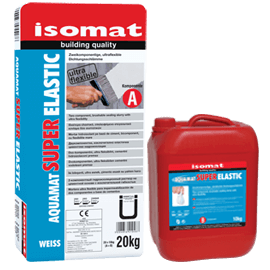AQUAMAT-SUPERELASTIC is a two-component, ultra-flexible waterproofing slurry offering the following advantages:
- Easy application with a brush, roller or airless spray in one layer up to 2 mm thickness.
- Total waterproofing against positive hydrostatics pressure up to 5 atm according to EN 12390-8. It can also withstand negative pressure.
- Crack-bridging ability even at low temperatures.
- Resistance to UV radiation.
- After hardening, it forms a seamless and jointless member.
- Excellent adhesion to surface such as concrete, plaster, bricks, etc.
- High vapor permeability and resistance to frost.
- Resistance to aging caused by temperature fluctuations.
- Resistance to chemicals, such as de-icing salt, sulfates, chlorides, etc.
- Protection of concrete from carbonation.
- No corrosive effect on the reinforcing steel in concrete.
It is used for waterproofing surfaces made of concrete, plaster, bricks, cement blocks, terrazzo, gypsum boards, wood, metal, etc. Ideal in cases where ultra flexibility and excellent adhesion of the waterproofing layer are required. Suitable for waterproofing substrates that are subject to expansion-contraction or vibration and show or are expected to show hairline cracks, such as flat roofs, swimming pools, etc. Tiles should be fixed with a high-performance, polymer-modified tile adhesive, such as ISOMAT AK-22, ISOMAT AK-23 XXL, ISOMAT AK-25, ISOMAT AK-ELASTIC, ISOMAT AK-MEGARAPID.
Application
The entire contents of the 20 kg bag (component A) is added to the 10 kg of liquid component B under continuous stirring, until a uniform, viscous mixture is formed, suitable for brush application. The entire surface of the substrate should be dampened well, but without ponding water. The material is applied with a brush in two or more layers, depending on the water load. Layers thicker than 2 mm should be avoided, because the material may crack. Each new layer is applied after the previous one has dried. The freshly coated surface should be protected from high temperatures, rain and frost. In case AQUAMAT-SUPERELASTIC needs to be locally reinforced (inside corners where forming fillets is not necessary, atjunctions, etc.), the use of a 10 cm wide strip of polyester fleece (30 g/m2) or fiberglass mesh (65 g/m2) is recommended.
Substrate preparation
- The substrate must be clean, free of oil or grease, loose material, dust, etc.
- Water leaks should be plugged with AQUAFIX ultra rapid-setting, cementitious leak-plugging mortar.
- Any cavities on concrete surface should be filled and smoothed with DUROCRET, DUROCRET-PLUS, RAPICRET, or a cement mortar improved with ADIPLAST, after all loose aggregate has been removed and the surface has been well dampened.
- Starter bars and wooden molds should be cut to a depth of about 3 cm into the concrete and the holes should be sealed, as described above.
- Existing construction joints are opened longwise in a V shape to a depth of about 3 cm and are subsequently filled as above.
- Corners, like wall-floor junctions, should be filled and smoothly rounded off with DUROCRET, DUROCRET-PLUS or a cement mortar improved with ADIPLAST (formation of a fillet, triangular in cross section, with sides of 5-6 cm).
- In case of masonry walls, joints should be first filled carefully, otherwise it is recommended to apply a cement mortar layer first improved with ADIPLAST.




